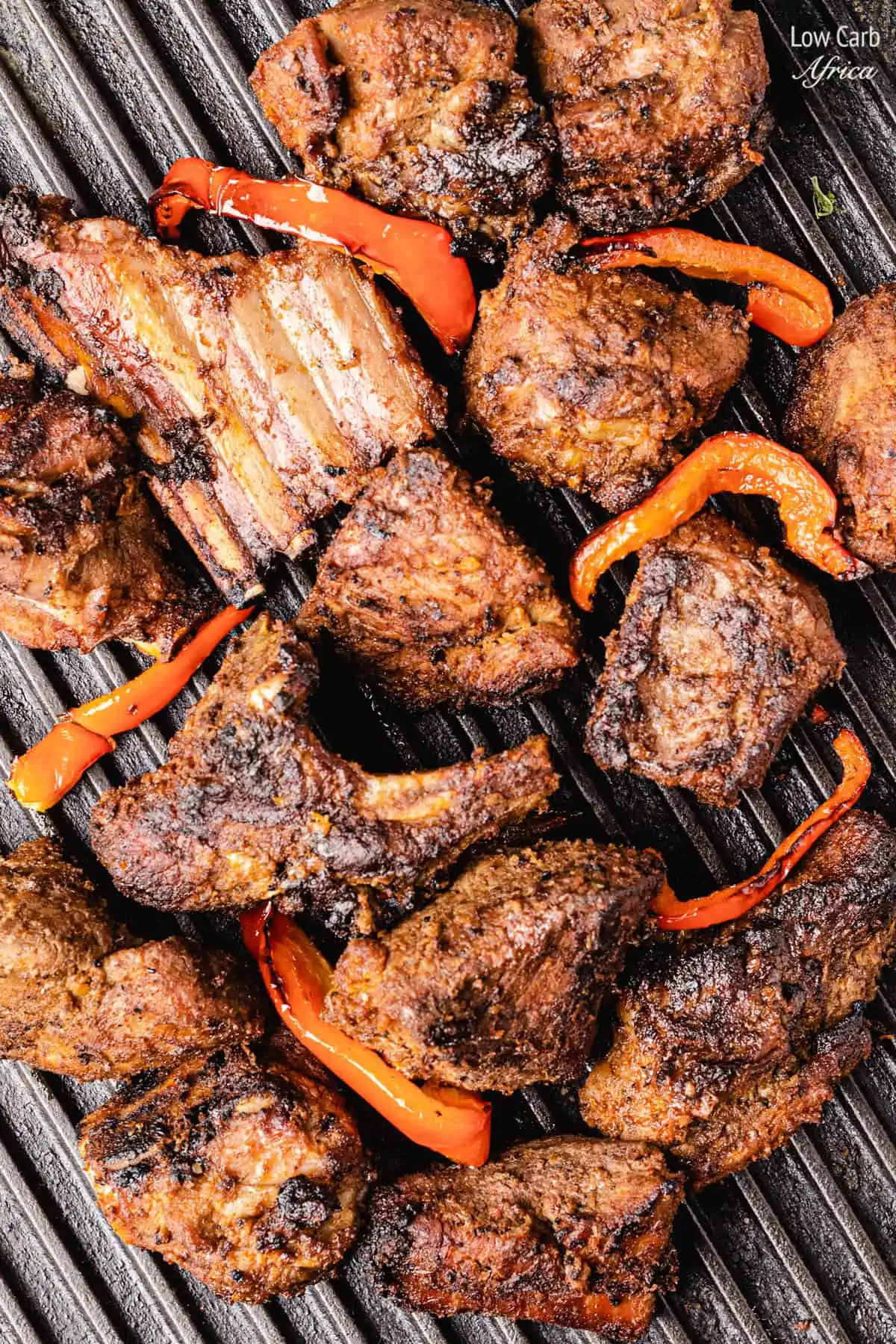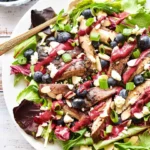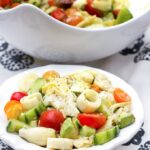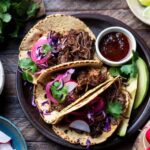African cuisine is a rich and diverse tapestry of flavors, influenced by a wide range of cultures and traditions across the continent. Each region boasts its own unique dishes, often made from fresh, local ingredients that reflect the area’s history and environment.
Discovering traditional African food recipes offers a journey into the heart of Africa’s culinary heritage, providing a taste experience like no other. Whether you’re a novice cook or an experienced chef, these recipes bring the vibrant and diverse tastes of Africa directly into your kitchen.
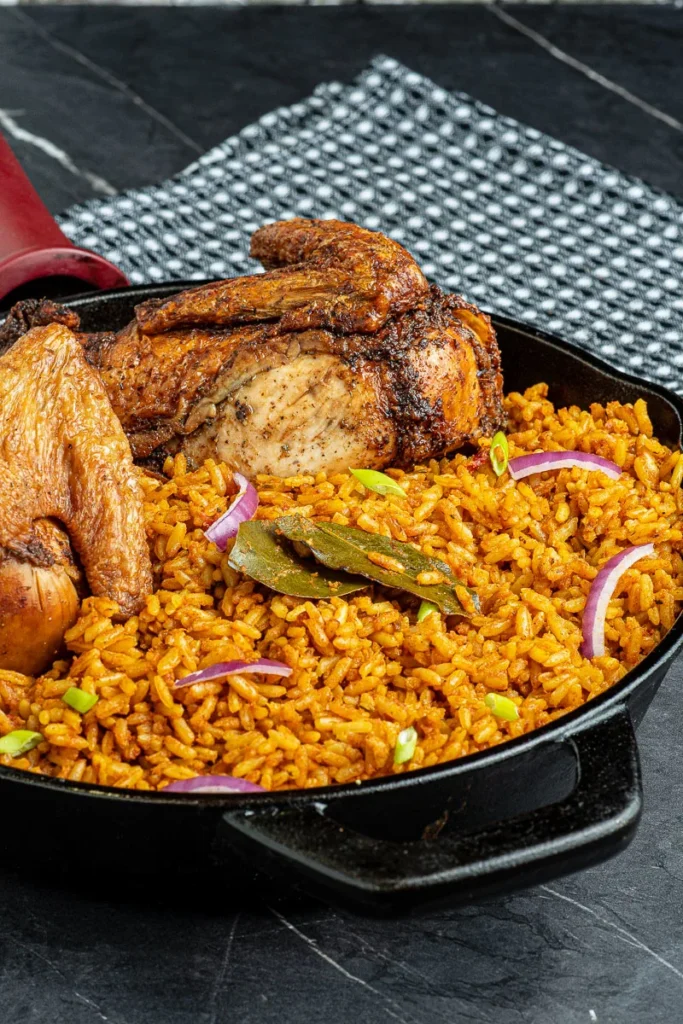
1) Jollof Rice
Jollof Rice is a beloved West African dish that’s both flavorful and fragrant. It’s enjoyed in many countries, including Nigeria, Ghana, and Senegal. Each country has its own twist on the recipe, but the basics remain the same.
You start by cooking a tomato-based sauce made from tomatoes, onions, and peppers. Adding spices like thyme, curry powder, and bay leaves enhances the flavor.
The rice is then mixed with the sauce and cooked until it absorbs all the rich flavors. Some people add vegetables like carrots and peas for more texture.
A key step is using foil or a tight lid to trap steam, which helps the rice cook evenly. This method also locks in the aromatic scent that makes Jollof Rice irresistible.
Often, it’s served with chicken or fish, but it’s delicious on its own too. Whether you’re cooking for a family meal or a special occasion, Jollof Rice never disappoints.
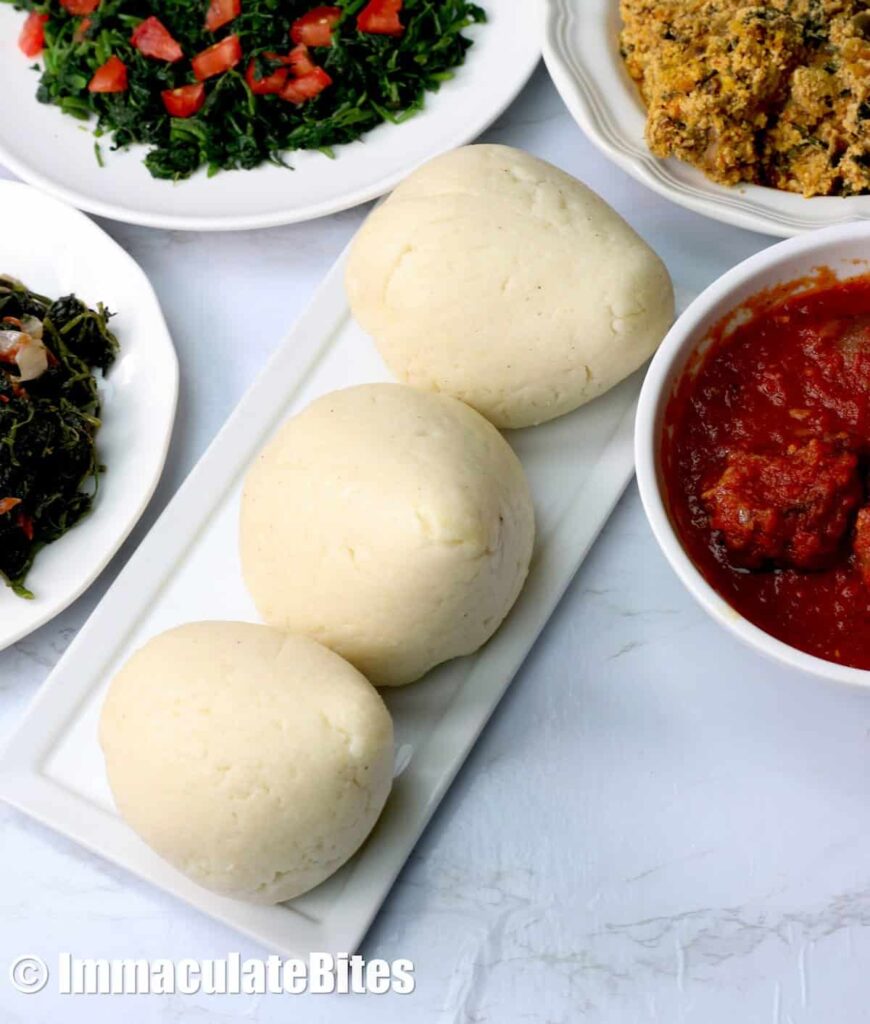
2) Ugali
Ugali is a staple food in many East African countries, including Kenya and Tanzania. It’s a simple dish made primarily from maize flour and water. Despite its simplicity, Ugali holds a special place in many households and is enjoyed with a variety of side dishes like vegetables, meats, and stews.
To make Ugali, you start by boiling water in a pot. Once the water is hot, you slowly add maize flour while stirring continuously. It’s essential to stir well to avoid lumps. The mixture will soon start to thicken.
As the Ugali thickens, keep stirring to ensure it cooks evenly. Once it reaches a thick, dough-like consistency, reduce the heat and cover the pot. Let it cook for an additional 10-15 minutes, stirring occasionally to prevent sticking.
When the Ugali is fully cooked, it should pull away from the sides of the pot. It’s served hot, often shaped into a rounded mound. You can pair it with sauces, meats, or vegetables. Ugali is not only filling but also versatile, making it a beloved dish in many African kitchens.
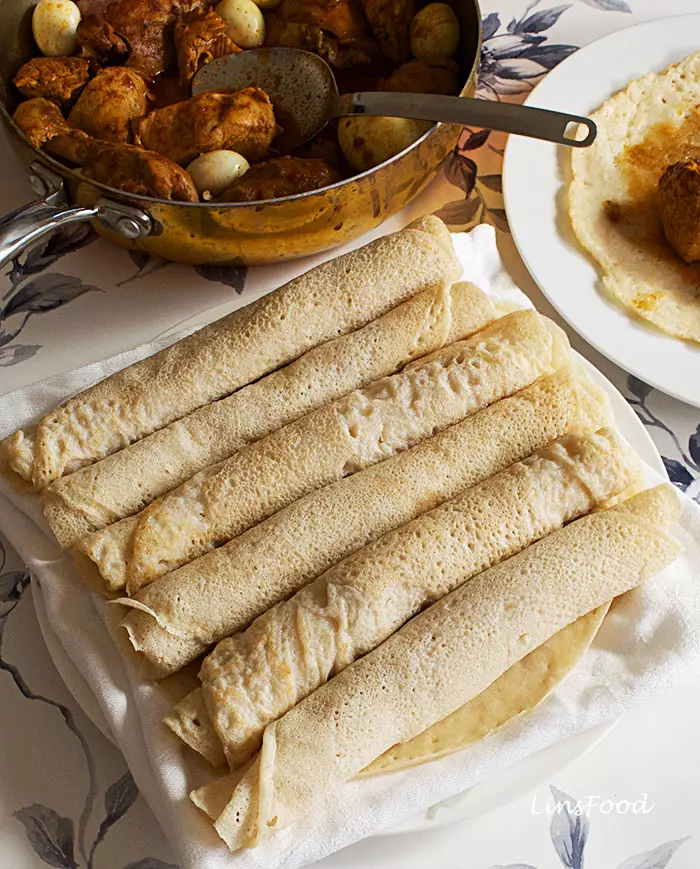
3) Injera
Injera is a staple flatbread in Ethiopia and Eritrea. Made from teff flour, this spongy, slightly sour bread is a unique part of many meals. You will often see it as the base for various stews and salads.
To make injera, you start by mixing teff flour with water. Let the batter ferment for a couple of days. This fermentation process gives injera its distinctive taste and bubbly texture.
Heat a non-stick skillet over high heat. Pour the batter in a spiral pattern, starting from the outside and moving inward. Cook the injera until bubbles form and pop. Cover the skillet for a few more minutes to let it steam and fully cook.
Serve injera warm. It typically complements dishes like Doro Wat or Misir Wat. You tear pieces of the injera to scoop up the stews, making each bite flavorful and satisfying.
Using teff flour keeps injera gluten-free. Its nutritional benefits, including high fiber and protein content, make it a healthy addition to any meal. Whether you’re new to Ethiopian cuisine or it’s already a favorite, injera always adds a special touch.
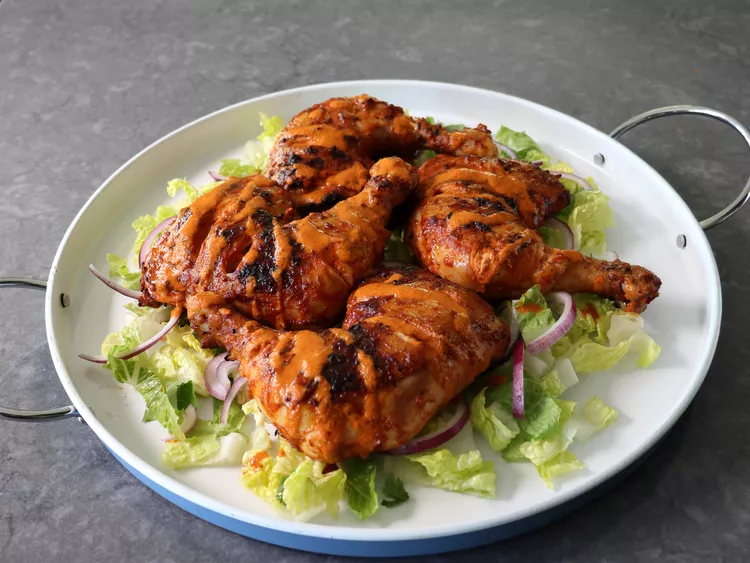
4) Piri Piri Chicken
Piri Piri Chicken is a flavorful and spicy dish that originated in Southern Africa. It’s known for its vibrant and zesty marinade, combining chili peppers, garlic, lemon, and a blend of spices.
Start by making the marinade. Blend together garlic, chili peppers, lemon juice, paprika, and salt. You can also add ginger and other spices if you like.
Rub the marinade all over the chicken and let it sit for at least an hour, but overnight is best. This helps the flavors really soak in.
When ready to cook, preheat your oven to 176 degrees Celsius (350 degrees Fahrenheit) or heat up your grill. Cooking on the grill gives the chicken a smoky flavor, but the oven works well too.
Cook the chicken until it’s browned and cooked through. This typically takes about 20-30 minutes. Be sure to flip the chicken halfway through to get an even cook.
Let the chicken rest for a few minutes before serving. This helps keep it juicy and tender.
Enjoy your Piri Piri Chicken with sides like rice, veggies, or flatbread. It’s a dish that brings a bit of Southern African warmth and spice to your meal.
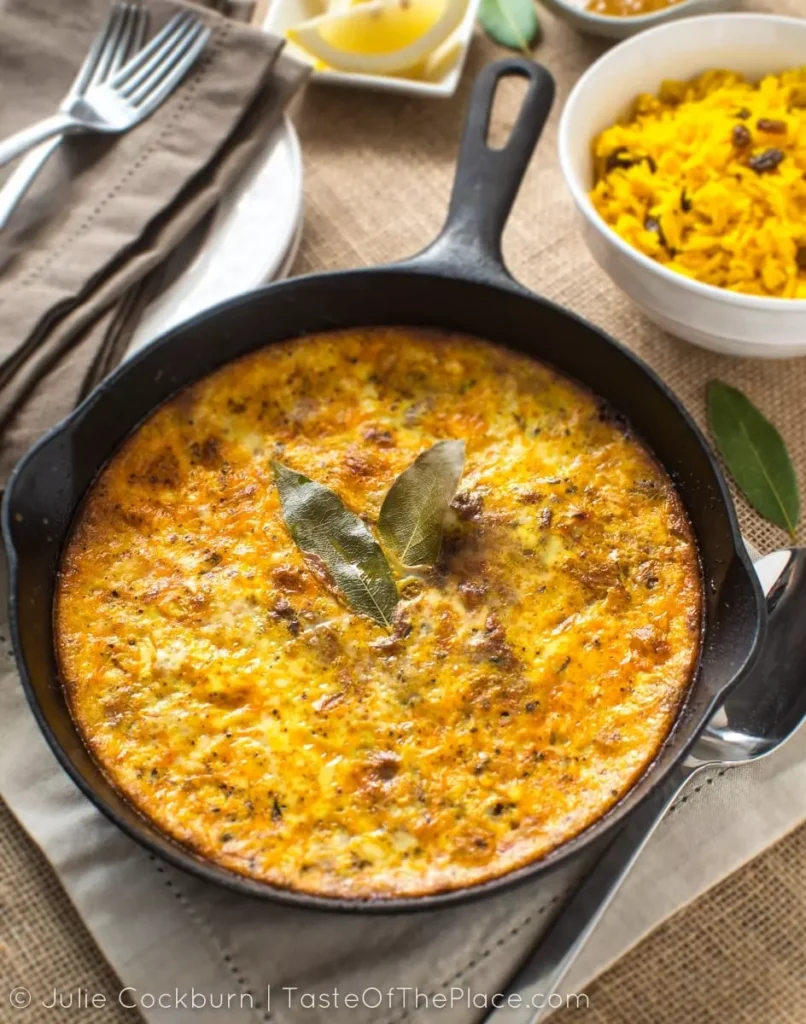
5) Bobotie
Bobotie is a traditional South African dish known for its unique blend of flavors. This savory baked casserole combines ground meat with spices, herbs, and a touch of sweetness.
First, you soak bread in milk, which will be mixed with the meat. This keeps the dish moist.
Next, you’ll sauté onions and garlic in a skillet until soft. Add curry powder, turmeric, and other spices like cumin and coriander to give Bobotie its distinctive taste.
After the onions and spices are ready, mix them with the soaked bread, ground meat, and any extras like almonds, sultanas, or chutney.
Once everything is combined, the mixture is browned lightly in a skillet.
Transfer it into a greased baking dish.
Finally, bake in a preheated oven until it’s firm and golden on top. Enjoy Bobotie with a side of yellow rice or a fresh salad.
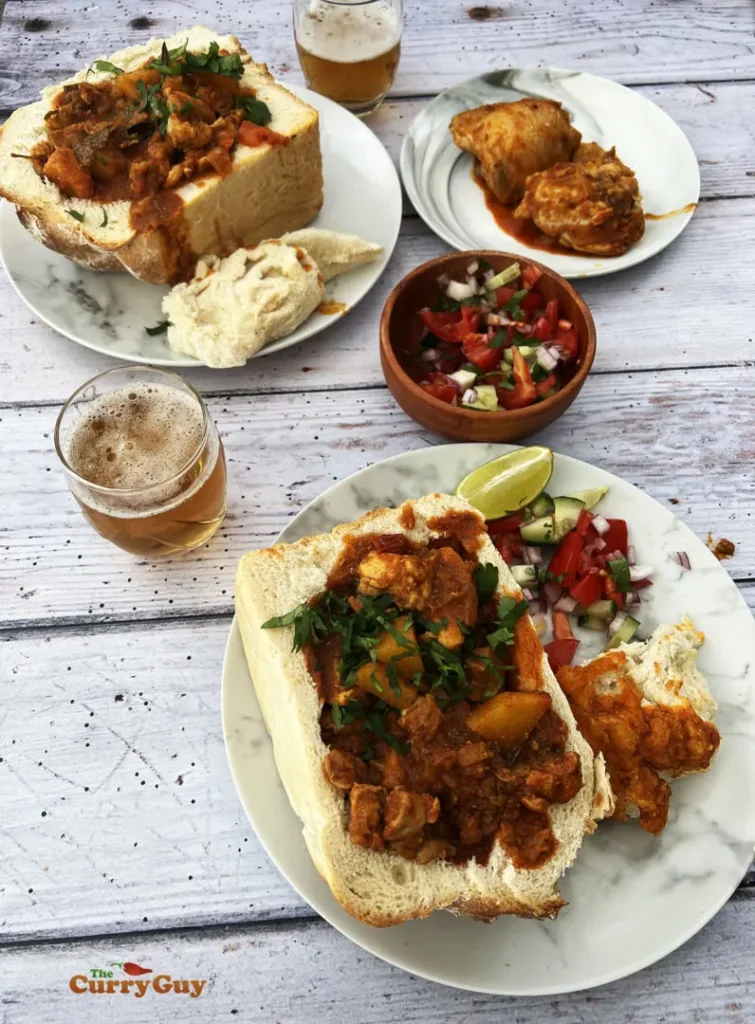
6) Bunny Chow
Bunny Chow is a popular South African street food. It consists of a hollowed-out loaf of bread filled with spicy curry.
To make Bunny Chow, start by frying onions until they are translucent. Then, add your spices and fry for another minute or two. Add diced tomatoes and cook until they form a paste.
Next, add your choice of meat. Common options include chicken, lamb, or beef. Don’t forget fresh ginger and garlic for extra flavor. Pour in some water or chicken broth and let it simmer.
Add potatoes and chickpeas if you like. Let the mixture simmer until the meat is tender and the sauce thickens. Adjust the salt and pepper to your taste.
Cut a loaf of bread in half and hollow out the inside. Fill the bread with your curry mixture. The bread soaks up the delicious flavors and makes a great edible bowl. Enjoy your Bunny Chow with friends and family.
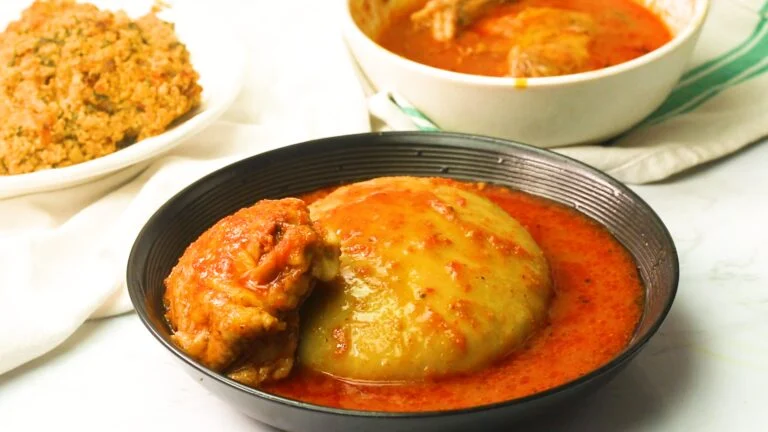
7) Fufu
Fufu is a popular West African dish made from starchy vegetables like yams, plantains, or cassava. It is typically served as a side with soups and stews.
To make cassava fufu, you mix cassava flour with boiling water. Stir the mixture until it forms a smooth dough-like consistency. This version is quick and easy.
Another method involves boiling unpeeled yams until tender. Peel them, chop into pieces, and mash or blend until smooth. Add salt and mix well.
For a microwave version, combine the batter in a microwave-safe bowl and cook for several minutes, stirring frequently. This method is convenient and less labor-intensive.
Fufu’s texture should be smooth and elastic. Serve it with your favorite African soups or stews. It’s a great way to enjoy traditional flavors.
Different regions have their own variations. Whether you use yams, plantains, or cassava, the result is a delicious, versatile dish.
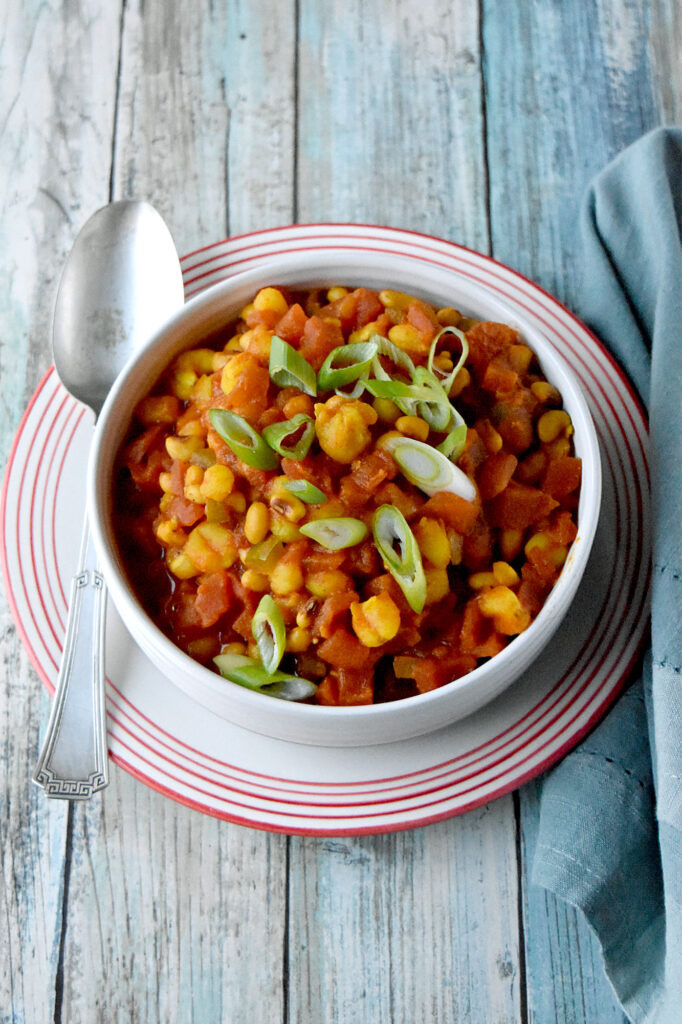
8) Samp and Beans
Samp and beans is a beloved South African dish made from dried corn kernels and beans. It is also known as Umngqusho in some regions. This dish is simple yet hearty, providing a comforting meal.
To start, you need to soak the samp and beans overnight in water. This step is essential to soften them. In the morning, rinse and drain.
Next, place the samp and beans in a large pot. Cover with fresh water and bring to a boil. Reduce the heat and let it simmer for about 1.5 to 2 hours until they become tender.
While the samp and beans are cooking, you can prepare a flavorful base. In a separate pan, sauté onions and garlic in oil until soft. Add spices like curry powder, paprika, or any preferred seasoning.
When the onions are ready, stir them into the pot with the samp and beans. Let everything cook together for another 30 minutes, allowing the flavors to meld. You can also add vegetables like carrots and bell peppers for extra flavor and nutrition.
Serve the samp and beans warm as a main dish or as a side. This dish is not only nutritious but also rich in taste, making it a favorite in many households.

9) Matoke
Matoke, also known as Ebitookye, is a type of banana. It is commonly called a cooking banana and is a staple in Uganda.
You begin by peeling the green bananas. They are then boiled or steamed until they become tender. You can mash them to create a smooth paste.
To add flavor, you might cook them with tomatoes, onions, and spices. Some recipes also include meat or beans for a more filling dish.
Traditionally, Matoke is served hot. It pairs well with stews, making it a versatile side dish.
In some variations, you’ll find it combined with beef, curry, and other vegetables. This adds depth and makes the meal more nutritious.
Cooking Matoke doesn’t take long. Typically, you’ll only need about 20-30 minutes for the bananas to soften. This makes it a quick and easy dish to prepare.
If you’re looking to try something different, Matoke is a great option. The combination of tender bananas and savory additions makes it unique and delicious.
You can experiment with different ingredients and spices to suit your taste. It’s an excellent way to explore traditional African cuisine in your kitchen.
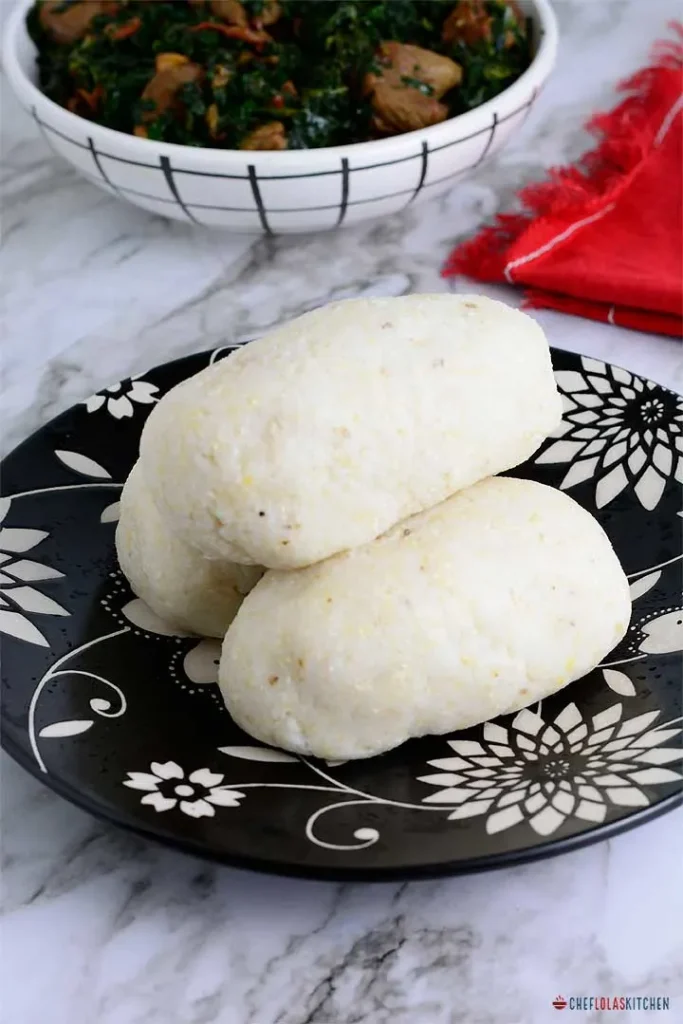
10) Sadza
Sadza, also known as Ugali, is a staple dish in Zimbabwe and many other African countries. It is made from maize meal (cornmeal) and water.
To prepare Sadza, start by mixing some maize meal with cold water to form a smooth paste. This helps prevent lumps when you cook it.
Next, boil water in a large pot. Gradually add the maize meal paste while continuously stirring with a wooden spoon or whisk. This step is crucial to achieve a smooth consistency.
As the mixture thickens, reduce the heat. Cover the pot and let it simmer for about 15 minutes. Stir occasionally to ensure it cooks evenly and doesn’t stick to the bottom.
If the Sadza becomes too thick, you can add a bit of water and stir until it is absorbed. If it’s too soft, let it cook a little longer until it reaches the desired thickness.
Sadza is traditionally served with vegetables, meat, or gravy. Its thick, dough-like texture makes it perfect for scooping with your hands. This simple yet satisfying dish is a cornerstone of African cuisine, cherished for its versatility and ease of preparation.
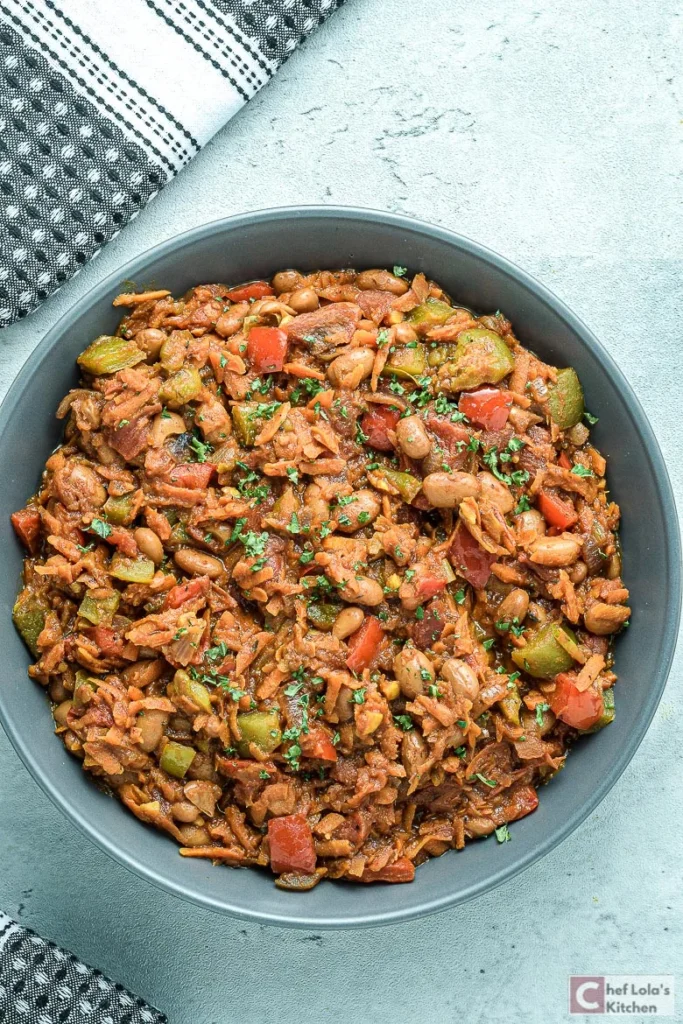
11) Chakalaka
Chakalaka is a popular South African dish known for its rich flavor and vibrant color. It’s a vegetable relish typically served with bread, pap, or meat.
To make Chakalaka, you start by frying onions in oil until they are soft. Add chopped green and red peppers, grated carrots, and cook for a few minutes.
Next, add diced tomatoes and season with salt and pepper to taste. You can also include red chili flakes for some heat. Cover the pan and let it cook on low heat until the mixture thickens but remains moist.
For extra flavor, you might want to add garlic, ginger, smoked paprika, and curry powder. These spices give Chakalaka its depth and aroma.
In some variations, people add baked beans to the mixture. This addition gives the dish more texture and makes it more filling.
Feel free to adjust the spices and vegetables to suit your taste. Chakalaka is a versatile dish that you can easily customize. It is typically enjoyed at barbecues (braais) or as a side dish with main meals.
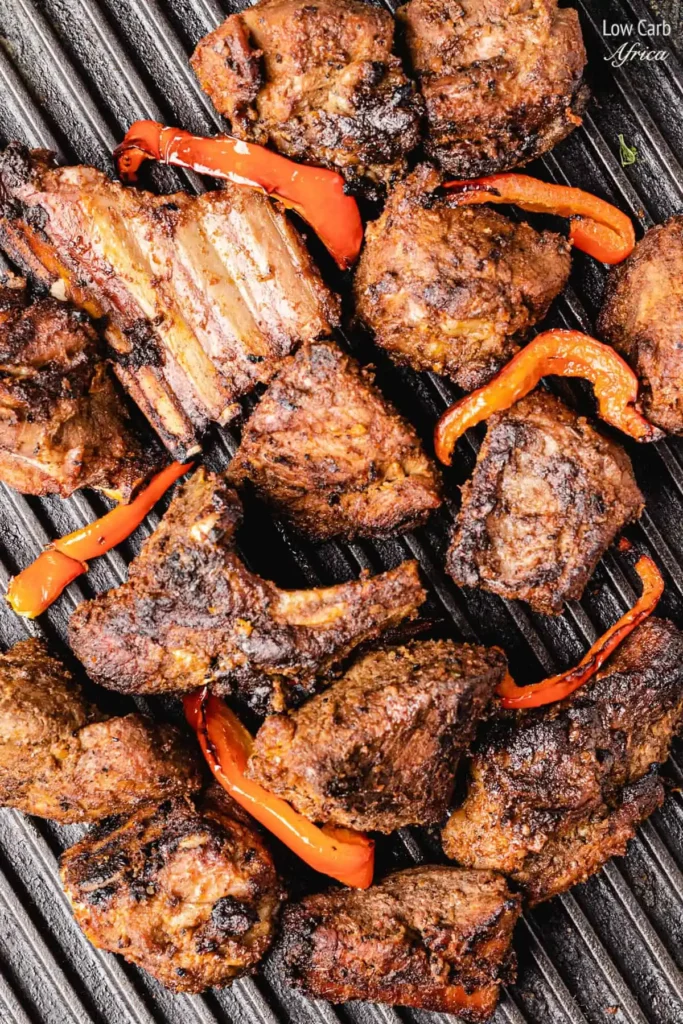
12) Nyama Choma
Nyama Choma is a popular grilled meat dish from Kenya. It’s often made with either beef or goat meat. The name “Nyama Choma” means “roasted meat” in Swahili. This dish is known for its rich, smoky flavor, which comes from grilling the meat over an open flame.
To prepare Nyama Choma, you start by making a marinade. Combine garlic, ginger, onion, lemon juice, olive oil, cumin, paprika, salt, and chili. These ingredients add depth and flavor to the meat. Make sure to coat the meat well with the marinade.
Marinating the meat for at least 2 hours or overnight helps to infuse the flavors. Once the meat is marinated, it’s ready to be grilled. You can use a charcoal grill or an oven if you don’t have a grill. Preheat your grill to medium-high heat.
Grill the meat, turning occasionally, until it is cooked to your desired level of doneness. The meat should be tender and have a nice char on the outside. Serve Nyama Choma with a side of vegetables, rice, or flatbread. Enjoy this flavorful and hearty dish!
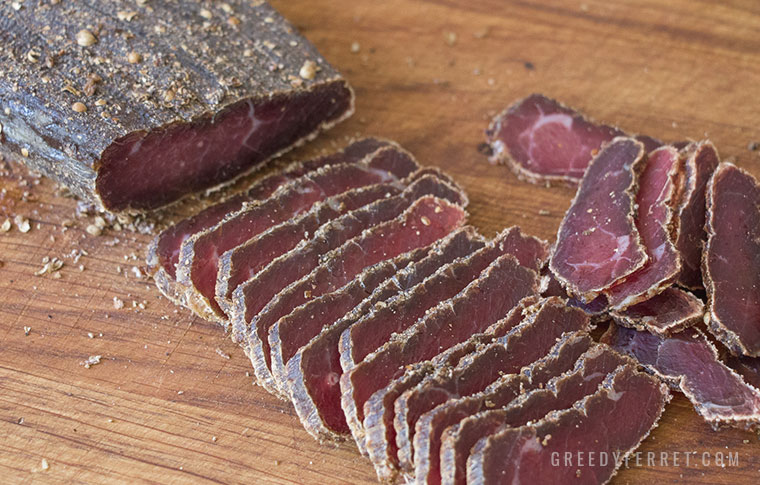
13) Biltong
Biltong is a popular South African snack made from dried, cured meat. It originated as a way to preserve meat before refrigeration was common. The word “biltong” comes from the Dutch words “bil,” meaning meat, and “tong,” meaning strip or tongue.
To prepare biltong, you need high-quality beef like topside or silverside. First, toast coriander seeds and grind them. This adds a distinct flavor. Cut the meat into 1-inch thick strips.
Rub these strips with vinegar to help with the curing process. Then, season the meat with a mixture of salt, black pepper, and ground coriander seeds. Make sure to cover the meat evenly.
Place the seasoned meat in a non-metallic container. Let it marinate for about 24-48 hours, turning the meat occasionally to ensure even curing. After this, hang the meat in a cool, dry place to air-dry.
Drying usually takes about 3-5 days, depending on the climate and personal preference. The end result should be dry but chewy, with a slightly gamey, spicy flavor. Biltong is enjoyed as a snack on its own or added to dishes for extra protein and flavor.
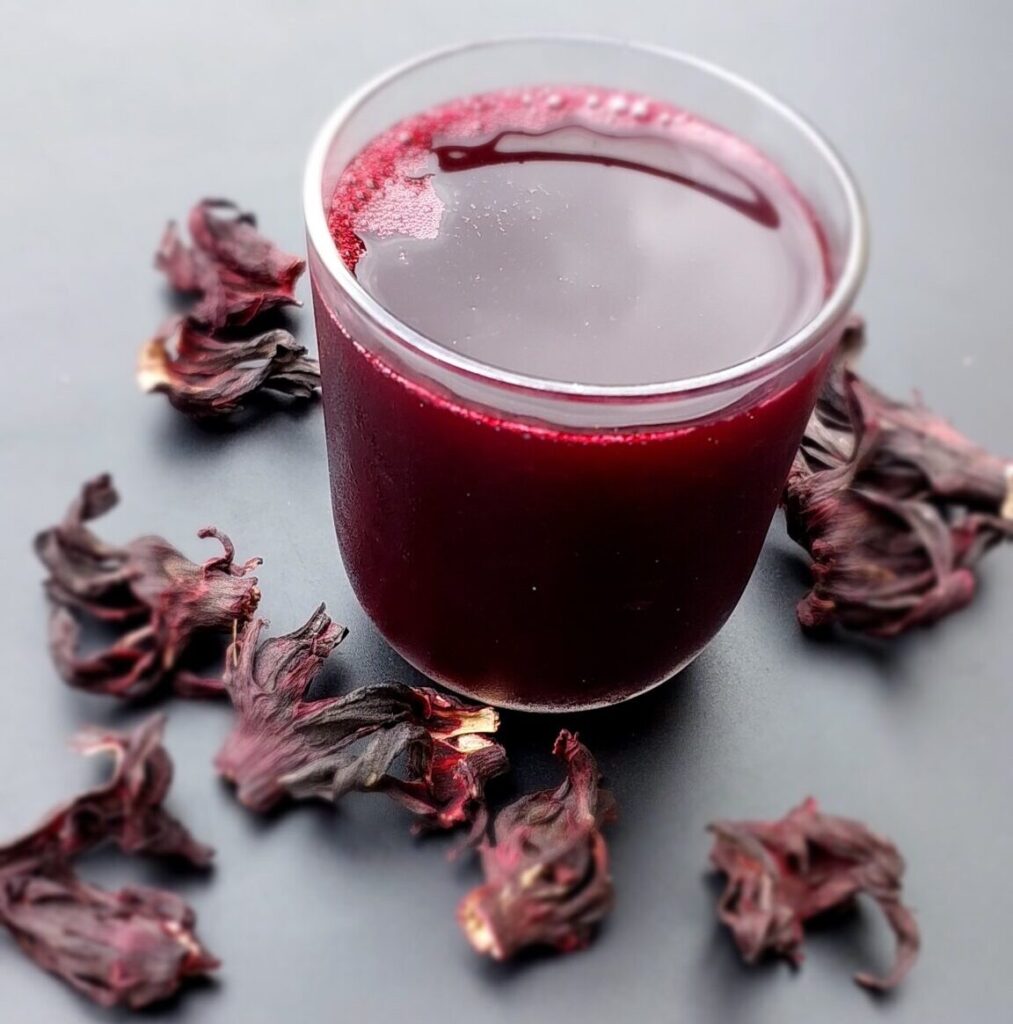
14) Zobo Drink
Zobo Drink, also known as Sobolo, is a popular beverage in many West African countries, especially Nigeria. Made from dried hibiscus petals, it’s not only refreshing but also packed with vitamins and antioxidants.
To make Zobo Drink, start by washing the dried hibiscus leaves thoroughly to remove any dust or dirt.
Place the cleaned leaves in a large pot. Add water to cover the leaves. Add pineapple chunks for natural sweetness and flavor.
Include ginger and cloves for a spicy and aromatic touch. You can also add a cinnamon stick if you like.
Bring the mixture to a boil over medium heat. Let it simmer for about 30 minutes. This allows the flavors to blend well together.
After boiling, let the mixture cool down slightly. Then, strain the liquid to separate the solids. You can use a sieve or cheesecloth for this.
Once strained, you can add a bit of sugar if you want it sweeter. Be careful not to make it too sweet.
Refrigerate the drink until it’s cold. Serve chilled over ice for a refreshing treat.
Zobo Drink is not only tasty but also has health benefits. Enjoy this traditional African beverage anytime you need a refreshing drink.
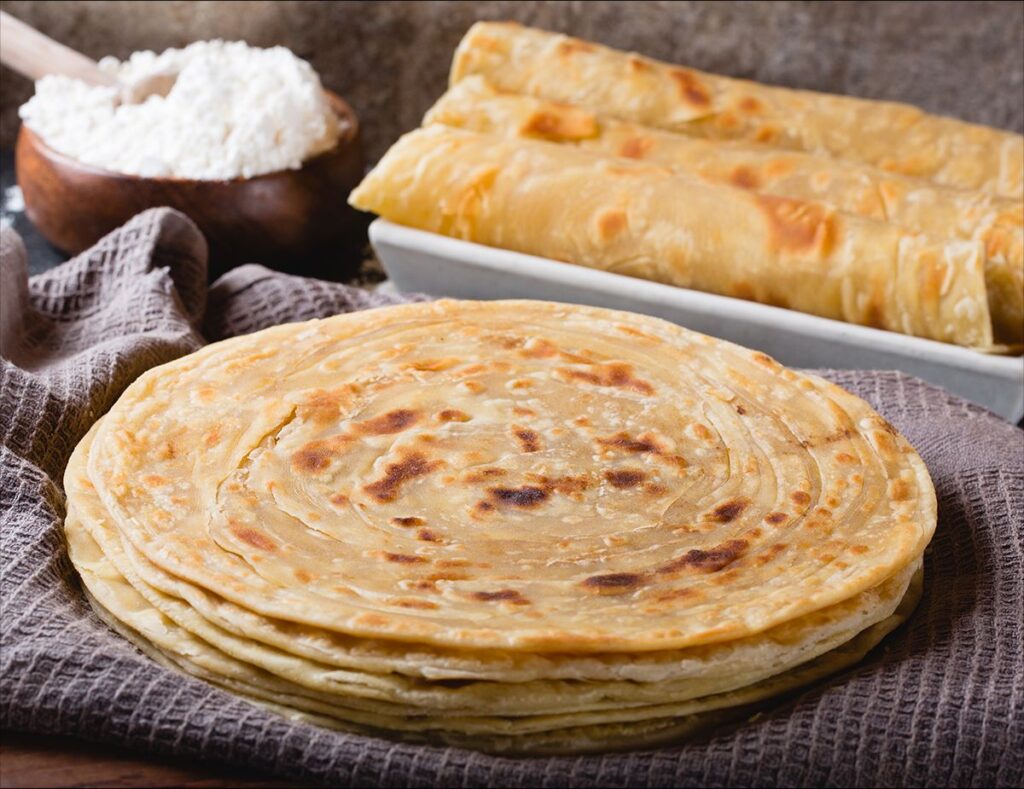
15) Chapati (Swahili Chapati)
Chapati is a popular flatbread in East Africa, especially in countries like Kenya and Tanzania. It’s a staple that accompanies many meals.
To make chapati, start by mixing flour, salt, and oil in a large bowl. Gradually add water until you form a soft, sticky dough. Knead the dough on a floured surface for about 10 minutes until smooth and elastic.
Next, divide the dough into equal portions and roll each into a ball. Flatten the balls and roll them out into thin circles. Heat a pan over medium heat and cook each chapati until golden brown spots appear on both sides.
Traditionally, ghee is used for cooking chapatis, but vegetable oil works too. The result is a soft, layered bread perfect for scooping stews or enjoying on its own.
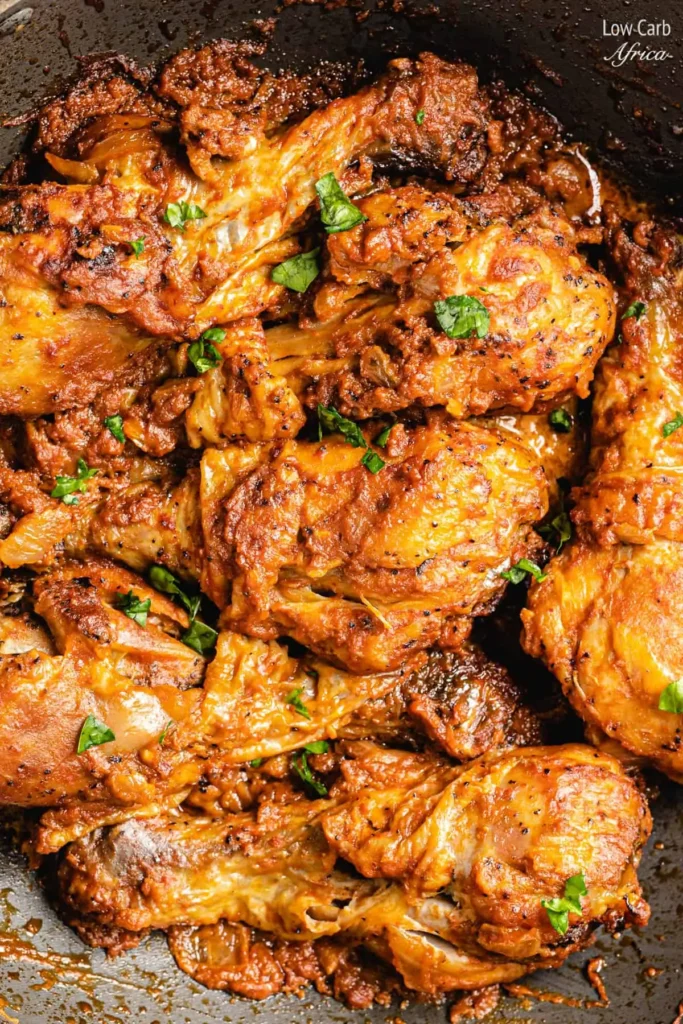
16) Moambe Chicken
Moambe Chicken is a beloved dish from Central Africa, often considered the national dish of the Republic of Congo. It’s known for its rich, savory flavors.
To start, season your chicken pieces with salt, pepper, paprika, and cayenne pepper. Let the chicken marinate for at least 30 minutes.
Next, heat some oil in a large pot over medium-high heat. Place the chicken in the pot and brown it on all sides until it develops a golden crust. This helps to lock in the flavors.
Once browned, remove the chicken from the pot. In the same pot, sauté onions until golden. Add minced garlic and cook until fragrant.
Now, return the chicken to the pot. Add tomato paste, stirring it in well. Allow the paste to darken slightly. This process helps to deepen the flavor of the sauce.
Pour in palm nut cream and chili pepper. Stir to combine everything. Add enough water or chicken broth to cover the chicken halfway. Bring the pot to a boil, then reduce the heat and let it simmer for about 40 minutes.
The chicken should be tender and the sauce thickened. To finish, you can add peanut butter to enhance the dish’s richness. Stir it well into the sauce before serving.
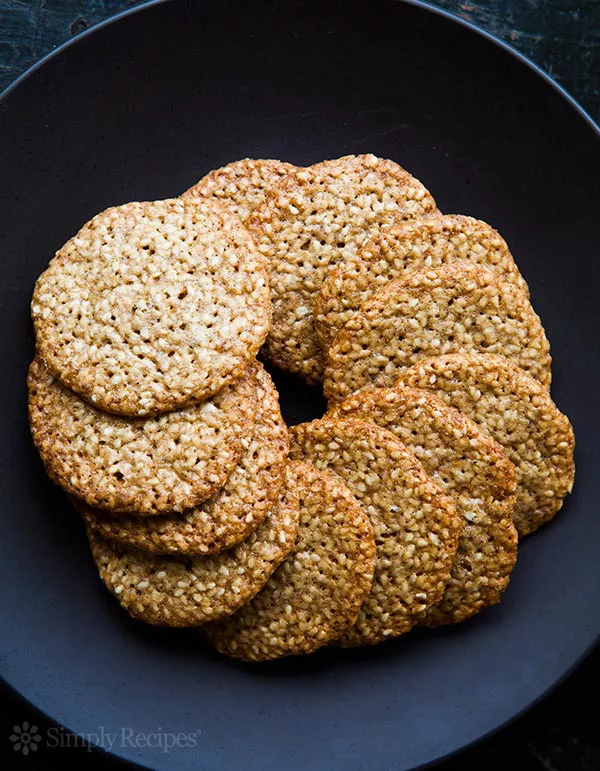
17) Benne Wafers
Benne Wafers are a traditional treat from the southern United States, particularly South Carolina. These crispy sesame seed cookies have roots that trace back to West Africa. The word “benne” means sesame in several Bantu languages, reflecting their African heritage.
To start, preheat your oven to around 350°F. Line your baking sheets with parchment paper or silicone mats.
In a large mixing bowl, cream together butter and brown sugar until fluffy. Then add an egg and vanilla extract. Mix well to combine.
In a separate bowl, whisk together flour, salt, and baking powder. Gradually add these dry ingredients to your butter mixture. Stir in toasted sesame seeds until the dough is smooth.
Drop the dough by tablespoonfuls onto the prepared baking sheets. Bake for about 10-15 minutes, or until the wafers are light brown around the edges.
Cool the baked wafers on a wire rack. You can store them in an airtight container and even reheat them briefly in a 250°F oven if they soften.
Benne Wafers are known for their unique nutty flavor and crunch, and they make a delightful snack or dessert.
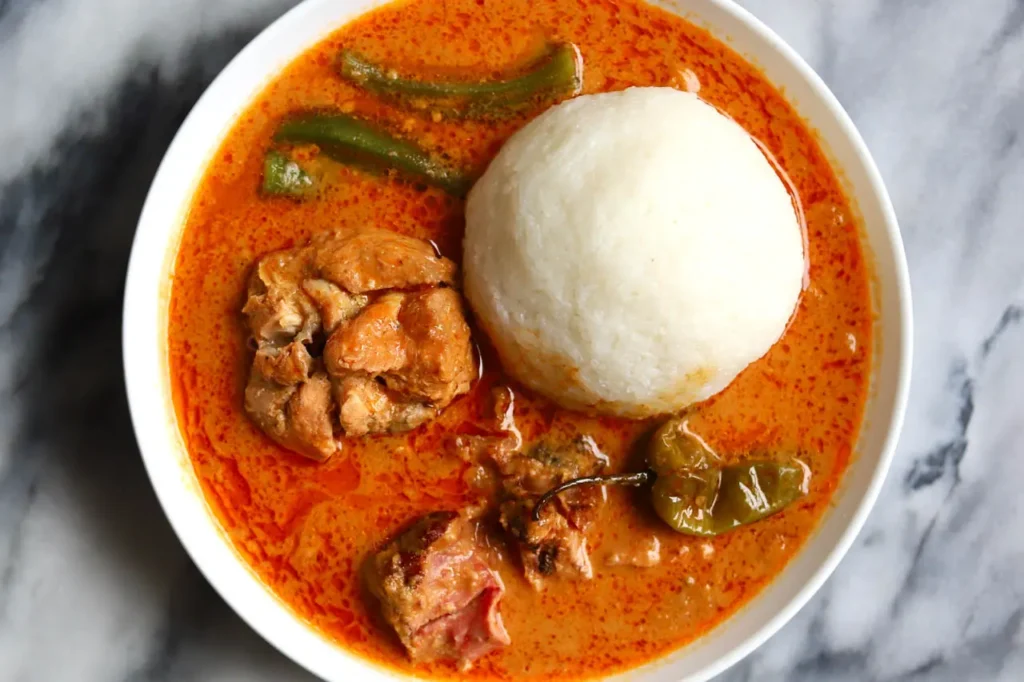
18) Ghanaian Groundnut Soup
Ghanaian Groundnut Soup, also known as Nkate Nkwan, is a rich and flavorful dish made with peanuts. It’s a favorite comfort food in Ghana and is enjoyed with rice balls, fufu, or yams.
This soup starts with a base of peanut butter, which is mixed with tomato paste and water to create a creamy, milky texture.
Next, onions, tomatoes, and sometimes hot peppers are added to a pot and simmered until they’re soft. These ingredients are then blended and stirred back into the soup to thicken it.
The soup often includes goat meat, chicken, or tripe. The meat is simmered in the peanut mixture until it’s tender, absorbing the rich flavors of the peanuts and tomatoes.
For a vegan version, tofu can replace the meat. You would add it toward the end of cooking to keep it from overcooking. The peanut and tomato base remains the same, ensuring a hearty and satisfying dish.
You can adjust the spice level by adding hot peppers like kpakpo shito to your taste. This makes it a versatile dish that can be as mild or as spicy as you prefer.
Serve your Ghanaian Groundnut Soup hot with your favorite side, and enjoy a taste of Ghana’s culinary heritage.
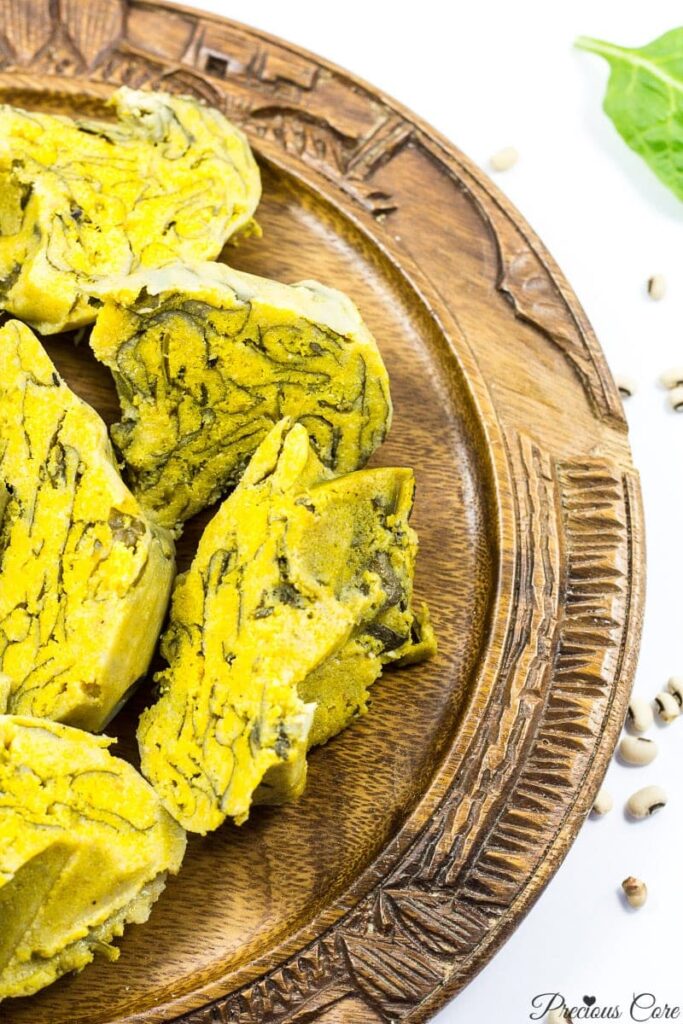
19) Koki Bean Cake
Koki Bean Cake is a delicious and traditional food from Cameroon. It’s made with a mixture of black-eyed peas and palm oil. You will first soak the dried black-eyed peas in water overnight to soften them. Then, drain and mash the soaked peas until you get a coarse paste.
Add water gradually while blending the beans. It’s important not to add too much water. Warm palm oil to a lukewarm state and mix it with the paste. Adding salt is crucial for flavor.
Next, you will wrap the mixture in banana leaves, which gives it a unique taste and texture. If you don’t have banana leaves, you can use aluminum foil. Place the wrapped mixture into a pot lined with leaves or foil to create a steamer.
Pour hot water into the pot, cover, and bring it to a boil. Cook the Koki Bean Cake for about 1 1/2 to 2 hours. Check occasionally to ensure it doesn’t burn or dry out.
Koki Bean Cake is best enjoyed with a side of plantains or yams. This dish is not only tasty but also rich in protein, making it a nutritious addition to your meal.
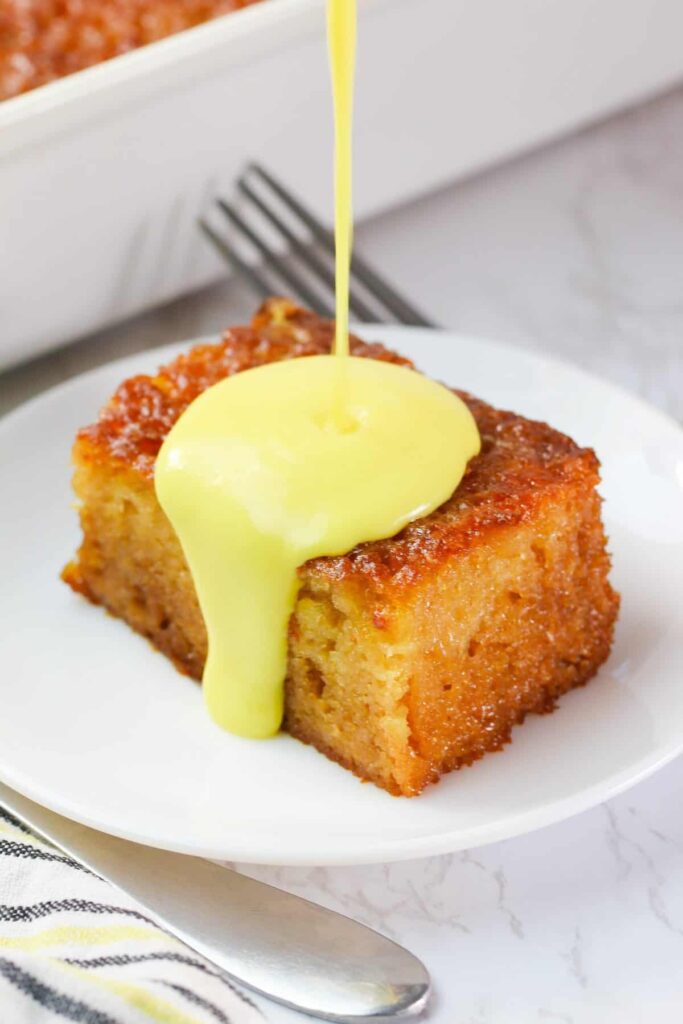
20) Malva Pudding
Malva Pudding is a traditional South African dessert that is rich and indulgent. This sweet treat features a moist sponge cake soaked with a buttery, caramelized sauce.
Start by preheating your oven to 180°C (350°F). Grease a baking dish. In a bowl, mix together butter, sugar, apricot jam, and eggs until the mixture is light and fluffy.
In another bowl, sift together flour, baking soda, and salt. Gradually add the dry ingredients to the wet mixture while slowly adding milk and vinegar. Stir until the batter is smooth and well combined.
Pour the batter into the greased baking dish. Place it in the oven and bake for about 30 minutes, or until the top is golden brown and a skewer inserted into the center comes out clean.
While the pudding bakes, prepare the sauce. In a small saucepan, combine butter, cream, sugar, and water. Heat the mixture until it boils, then simmer for 5 minutes.
Once the pudding is done, remove it from the oven and let it sit for a few minutes. Pour the hot sauce over the pudding and let it soak up for at least 10 minutes before serving.
Comments: Excellent traditional dessert for those who love rich, buttery flavors.
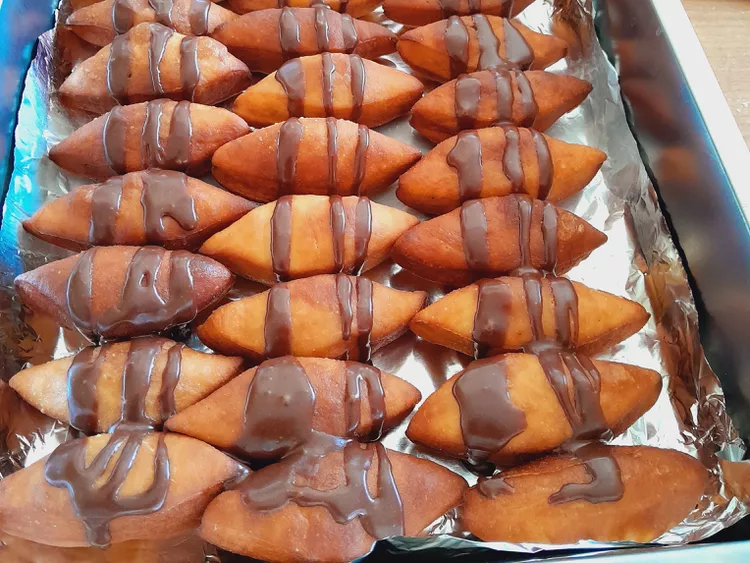
21) Mandazi
Mandazi, also known as African donuts, is a popular treat in East Africa. These slightly sweet, fried doughnuts have a hint of cardamom and are often enjoyed with tea or coffee.
To make Mandazi, you start by combining milk, sugar, and an egg. Then, add instant yeast, salt, and cardamom. Gradually mix in flour until the dough forms.
Knead the dough on a flat surface until it’s smooth and no longer sticky. Let it rise in a warm place until it doubles in size, which takes about one to two hours.
Once the dough has risen, divide it into portions and roll each out into circles. Cut the circles into quarters or any shape you like. Deep fry the pieces in hot oil until they are golden brown.
Enjoy your Mandazi warm, either plain or sprinkled with powdered sugar. They also pair well with coconut milk for added flavor. This versatile snack is perfect for gatherings or a cozy afternoon treat.

22) Kachumbari
Kachumbari is a fresh and vibrant salad popular in East Africa. It is made from simple, raw ingredients that come together to create a flavorful dish. You will only need tomatoes, onions, cucumber, jalapenos, and lime.
Start by washing all the vegetables thoroughly. Chop the tomatoes, onions, and cucumbers into small pieces. For a spicy kick, add finely chopped jalapenos.
To reduce the strong flavor of the onions, soak them in water with a bit of salt for about 10 minutes. Drain them well before mixing with the other ingredients.
Combine all the ingredients in a large bowl. Squeeze fresh lime juice over the mixture, bringing a tangy taste to the salad. Add salt and pepper to taste.
You can also include cilantro or parsley for an extra burst of freshness. Some versions of Kachumbari include avocado for a creamy texture.
Kachumbari is often served as a side dish with grilled meats, stews, or pilau. It adds a fresh contrast to rich, hearty dishes. Enjoy this easy-to-make, refreshing salad that captures the essence of East African cuisine.
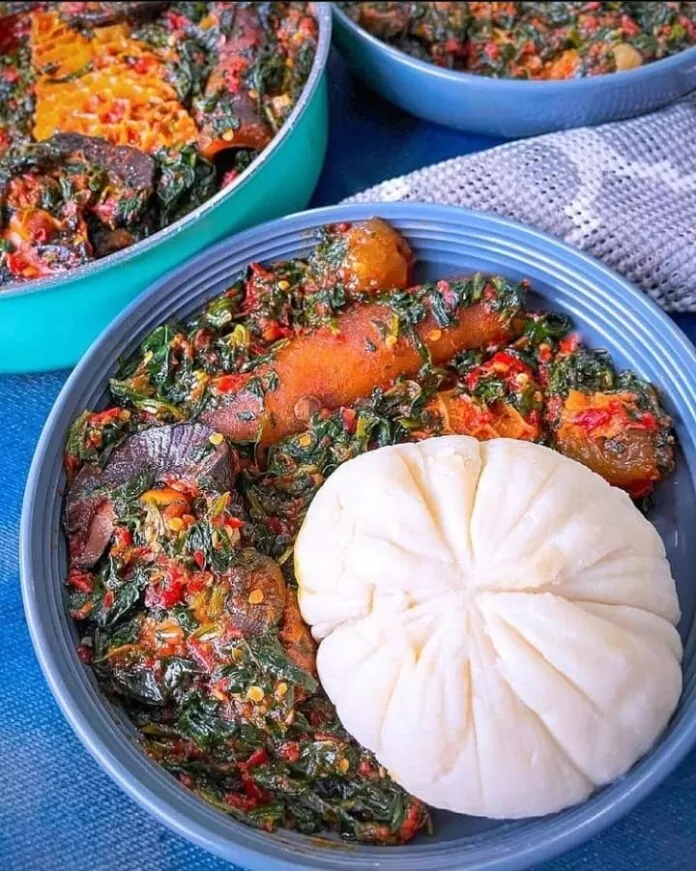
23) Pounded Yam
Pounded Yam is a popular dish in West Africa, especially Nigeria. It is often enjoyed with soups like Egusi, Ogbono, or Vegetable Soup.
To make Pounded Yam, you start by peeling and cutting white yams into small pieces.
Boil the yam pieces in water for about 20-30 minutes until they are soft and fork-tender.
Once cooked, you can either pound the yams in a mortar and pestle or use a food processor for a smoother consistency.
If using a food processor, blend the yams until they form a stretchy, smooth dough.
If the yam is too hard to pound or blend, you can add a little of the cooking water to help.
Pounded Yam is best served hot. It pairs perfectly with various soups and stews, soaking up the flavors beautifully.
This dish is not only delicious but also an essential part of many festive and daily meals in West Africa.
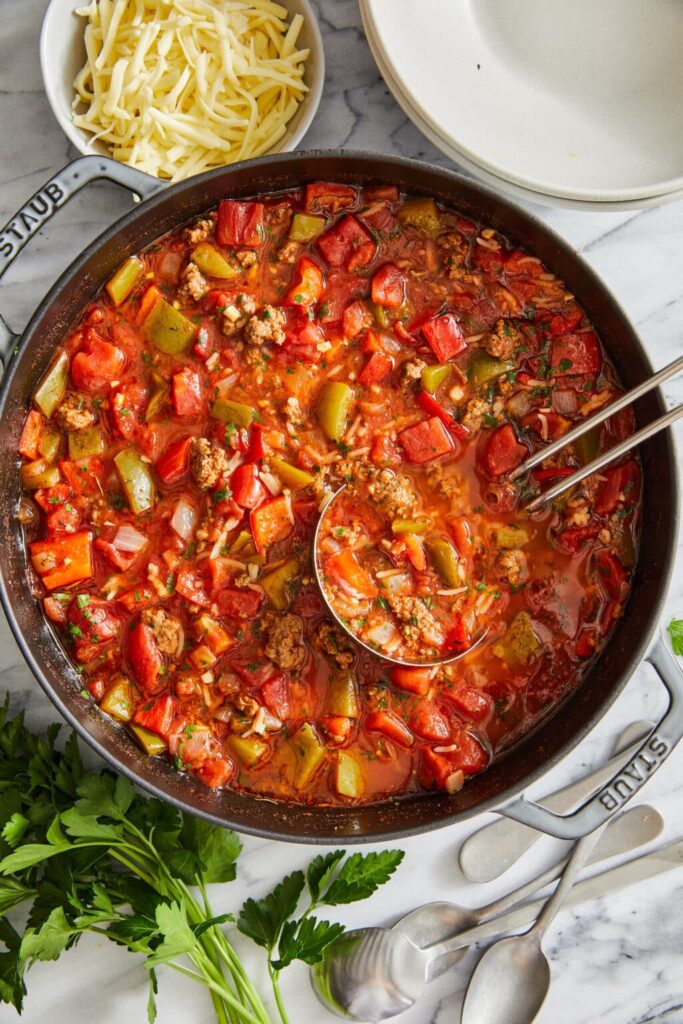
24) Pepper Soup
Pepper Soup is a popular dish in many African countries. It is known for its spicy and flavorful broth. You can make it with various types of meat such as goat, chicken, or fish.
To make Pepper Soup, start by cutting the meat into small pieces. Rinse the meat well before placing it in a pot. Add salt, a seasoning cube, and chopped onions. Cook the meat until it starts to release its juices.
Next, add pepper soup spices like red chili flakes, ginger powder, and crayfish. Also, include some habanero or scotch bonnet peppers for extra heat. Stir the mixture and let it cook for about 30 minutes.
If you’re making Nigerian Pepper Soup, you might toast and grind your own spices for an added layer of flavor. The spices usually include a mix of dried peppers and local herbs.
As the soup cooks, it will become rich and aromatic. Some versions of Pepper Soup also include vegetables like yams or plantains. Add these halfway through the cooking process to avoid them becoming too soft.
Serve Pepper Soup hot. It can be enjoyed on its own or with a side of rice or bread. This soup is perfect for chilly days or when you need something to warm you up.
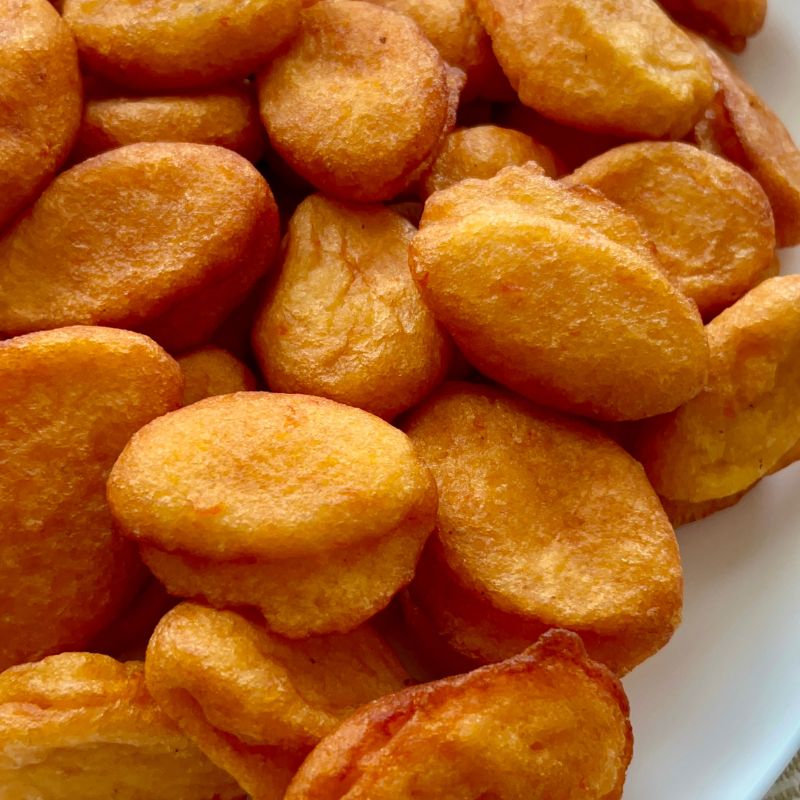
25) Akara
Akara, also known as bean fritters, is a popular dish in West Africa, especially in Nigeria. It’s made from black-eyed peas or other beans that are blended into a smooth paste.
To start, you need to soak the beans in water for a few hours. This helps to soften them. Once they are softened, peel off the skins by rubbing the beans between your hands or pulsing them briefly in a food processor. Rinse and drain to remove the skins completely.
Next, blend the peeled beans with a little water until you get a thick, smooth paste. You can then add onions, salt, and chili peppers to taste. Whisk the paste until it becomes light and fluffy.
Heat oil in a pan to about 350°F (175°C). Using a spoon, scoop small portions of the batter and drop them into the hot oil. Fry the akara until golden brown and crispy, which takes about a few minutes per side.
Akara is often served as a breakfast dish, accompanied by bread or pap, a type of cornmeal porridge. It’s also enjoyed as a snack or a side dish in various meals.
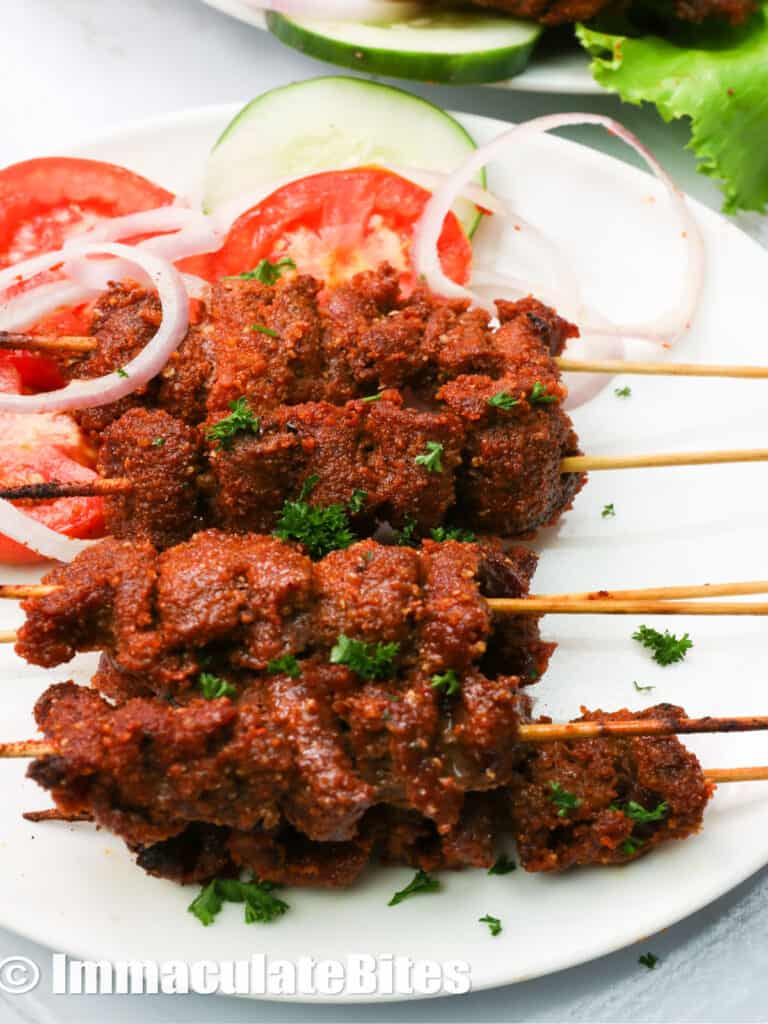
26) Suya
Suya is a popular West African dish, especially in Nigeria. It’s made from beef that is thinly sliced and marinated with a unique blend of spices known as suya spice or yaji. The beef is then threaded onto skewers for grilling.
To make suya, you’ll first coat the beef with oil and the suya spice. The spice mix typically contains ground peanuts, paprika, ginger, and cayenne pepper.
Once marinated, place the skewers on a grill or in an oven. Cooking takes about 8-20 minutes, depending on the method used and the grill’s heat. You should flip the skewers halfway through to ensure even cooking on all sides.
Serve suya with fresh vegetables like tomatoes, onions, and cucumbers. This dish is tasty and perfect for sharing with friends and family.
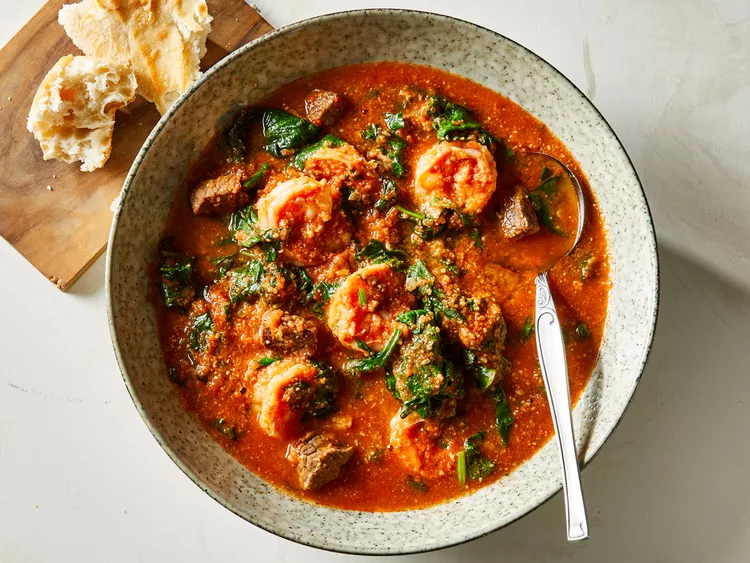
27) Egusi Soup
Egusi soup is a popular dish in West Africa, especially in Nigeria. It’s made from melon seeds, which are ground to form a thick, creamy paste. The soup has a rich, nutty flavor and is often enjoyed with fufu or pounded yam.
To start, blend onions and peppers with some water until smooth. Add the ground egusi seeds and mix until you get a thick paste. In a large pot, heat some palm oil and add the blended mixture.
Scoop teaspoon-sized balls of the egusi paste into the pot. Let these balls cook in the soup until they hold their shape. Add meat, fish, or other proteins of your choice. You can also add stock fish and crayfish powder for extra flavor.
Simmer the soup until everything is well cooked. Adjust the consistency by adding more water, if needed. Serve your egusi soup hot with fufu, pounded yam, or another starch.
Egusi soup is not only delicious, but it’s also nutritious. It’s packed with protein from the melon seeds and the added meats or fish. Enjoy this West African staple in the comfort of your home.
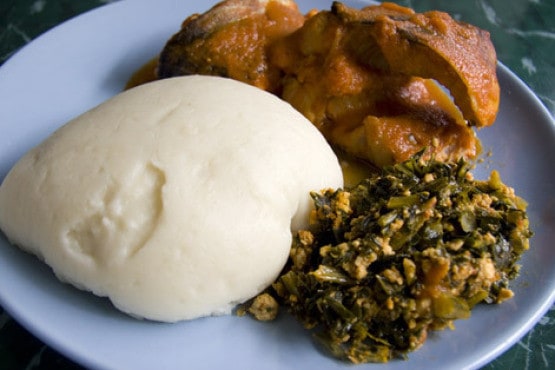
28) Nsima
Nsima is a staple food in Malawi. It’s made from cornmeal and is similar to porridge. Traditionally, you prepare it with maize flour and water.
To make nsima, start by bringing water to a boil in a large pot. Slowly add some cornmeal to the water, stirring nonstop to avoid lumps.
Once the mixture begins to thicken, reduce the heat. Gradually add the remaining cornmeal, continuing to stir until the mixture forms a smooth, thick paste.
Let the nsima steam for about 10 minutes. Stir it occasionally to maintain the right texture. Scoop it into balls for serving.
Nsima is usually served with vegetables, meat, or fish. It pairs well with sauces and soups, making it a versatile part of any meal.
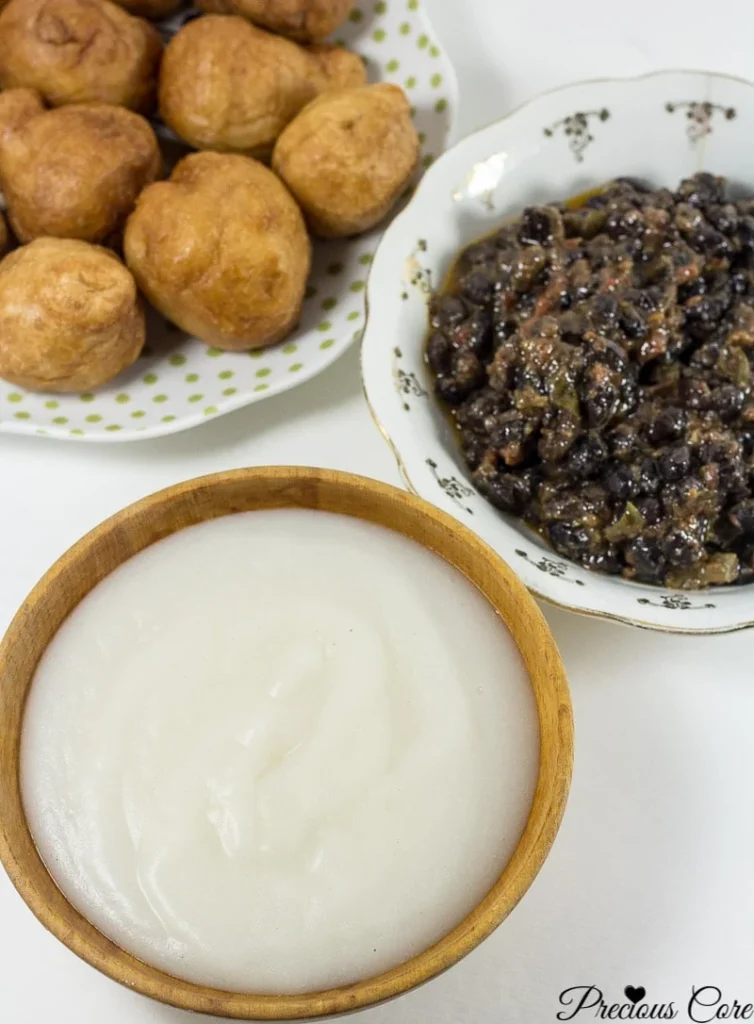
29) Ogi (Pap)
Ogi, also known as Pap, is a popular African corn pudding. It has a smooth, custard-like texture and is usually served as a breakfast dish.
To make Ogi, you need dry corn. Start by washing the corn thoroughly and soaking it in cold water for about 3 to 4 days. Make sure to change the water daily to avoid any bad smells.
Once the corn has soaked and is tender, blend it until it becomes smooth. After blending, strain the mixture to remove any coarse particles. The strained liquid needs to ferment for a few more days until it develops the right sour taste.
When you’re ready to cook, mix the fermented Ogi with some cold water until it is smooth. Then, pour boiling water over the mixture while stirring continuously until it thickens.
Serve your Ogi with milk, sugar, or even some honey for a bit of sweetness. This dish can be enjoyed by both adults and kids, making it a versatile option for your breakfast table.
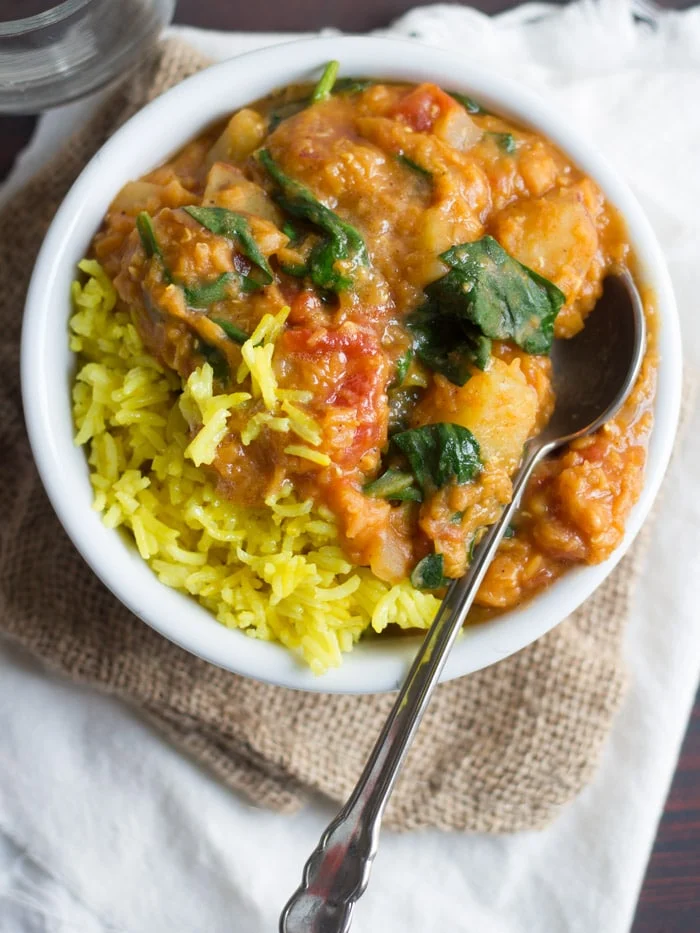
30) Ethiopian Lentil Stew
Ethiopian Lentil Stew, also known as Misir Wot, is a hearty and flavorful dish. It features red lentils cooked in a rich, spiced sauce. This stew is a staple in Ethiopian cuisine and offers a unique blend of spices.
To make this dish, start by heating oil or Ethiopian spiced butter in a pan. Add chopped onions and cook until they become translucent. Then, mix in garlic, ginger, and berbere spice. Berbere is a key ingredient, giving the stew its distinctive heat and flavor.
Next, add tomato paste and stir well. Incorporate rinsed red lentils into the mixture. Pour in water or stock, and season with salt. Let the stew simmer until the lentils are soft and the flavors meld together.
Pair this stew with injera, a traditional Ethiopian flatbread, to soak up the savory sauce. The combination of lentils and spices creates a comforting meal that is both nutritious and satisfying. Enjoy the rich flavors and diverse aromas of Ethiopian Lentil Stew.
Cultural Significance of Traditional African Food
Traditional African food is deeply rooted in history and varies across regions. These foods are significant because they reflect the diverse cultural practices and daily life in many African communities.
Historical Context
African cuisine reflects the history and experiences of its people. Ingredients like yams, plantains, and millet have been staples for centuries. Traditional cooking methods, such as boiling, steaming, and roasting, are passed down through generations. Soul food in the United States, for instance, shows the influence of African traditions carried over by enslaved people. These dishes embody survival and adaptability, preserving cultural identity despite external changes.
Other popular historical dishes include Jollof rice, originating from West Africa, which has become a symbol of celebration. This dish combines rice with tomatoes, onions, and peppers, demonstrating how food links to communal events and family gatherings. Interestingly, food often acts as a medium to share and sustain cultural narratives.
Regional Variations
Africa’s diverse geography results in distinct culinary practices in different regions. For example, North African cuisine features spices like cumin and coriander, reflecting Mediterranean and Middle Eastern influences. Dishes like tagine and couscous are common in countries like Morocco and Algeria, showcasing flavors unique to these areas.
West African cuisine emphasizes grains and tubers. Ghana’s Banku and Nigeria’s Egusi soup highlight the use of local ingredients like cassava and melon seeds. In East Africa, Ugali and Nyama Choma are staples, influenced by both indigenous and colonial histories. Meanwhile, South African foods such as Biltong and Bobotie represent a blend of local traditions and European influences.
These regional specialties not only cater to local tastes but also reveal the agricultural practices and environmental conditions of each area. They are central to cultural ceremonies, daily meals, and community bonding.
Key Ingredients and Their Uses
African cuisine offers a vivid palette of flavors through ingredients like staple foods and a unique blend of spices and herbs. Understanding these basics can elevate your cooking experience and bring authenticity to your dishes.
Staple Foods
African dishes often rely on staple foods like rice, yams, and maize. Rice is especially prominent in West African cuisine where you’ll find it in dishes like Jollof Rice. This one-pot dish combines rice with tomatoes, pimento peppers, and spices for rich flavor.
Yams and maize are essential in East and West African cultures. They can be boiled, fried, or mashed. Ugali, a firm maize porridge from East Africa, is a versatile side dish that complements stews and meats. Similarly, yams are used in traditional dishes like Pounded Yam in Nigeria, which serves as a base for soups and stews.
Cassava and plantains also play major roles. Cassava is used in Fufu and plantains can be fried or boiled. Both pair well with sauces and enhance the main dishes.
Spices and Herbs
African recipes come alive with a variety of spices and herbs. Curry powder, paprika, and ginger add depth to stews and curries. Blends like Berbere from Ethiopia feature a mix of chili peppers, garlic, coriander, and fenugreek, creating a robust profile.
Ginger and garlic are universal enhancers found in many recipes. Scotch bonnet peppers provide significant heat and are common in West African dishes like Jollof Rice and soups.
Herbs like coriander, parsley, and mint are often used fresh, adding both flavor and color. For instance, Kachumbari, a fresh tomato and onion salad, frequently includes coriander and parsley for zest.
Understanding these ingredients will help you recreate the authentic flavors of African cuisine in your own kitchen.
Cooking Techniques and Methods
African cuisine uses various cooking techniques, from deep-rooted traditional methods to modern adaptations. These techniques ensure the dishes are flavorful and rich in culture.
Traditional Cooking Methods
Traditional methods rely heavily on natural elements. One common technique is the earth oven, where a hole is dug, lined with stones or clay, heated with firewood, and then used to cook food slowly. This method is ideal for cooking large cuts of meat or root vegetables.
Another technique is slow simmering. African stews, made from meat, fish, vegetables, and legumes, benefit from this method as it helps develop rich flavors over time. Slow simmering is crucial for dishes like Moroccan tagines and Nigerian egusi soup.
Grilling is popular for meat, especially in West Africa where it’s known as “suya.” Meat skewers are spiced and grilled over open flames, giving them a smoky flavor.
Fermentation is another traditional technique, used for making dishes like injera in Ethiopia. The process not only preserves the food but also adds unique tangy flavors.
Modern Adaptations
Today, many traditional dishes are adapted for modern kitchen appliances such as ovens, stovetops, and slow cookers. For instance, instead of using an earth oven, a regular oven can achieve similar results without the time-consuming setup.
Air fryers are increasingly popular for healthier cooking. Plantains, commonly fried in oil, can be air fried to achieve that crispy texture without the excess fat.
Pressure cookers are also useful. They reduce cooking time while maintaining the depth of flavors typical in slow-cooked stews. Dishes like Senegalese thieboudienne and South African potjiekos can be prepared more quickly with this appliance.
Blenders and food processors make it easier to prepare bases for sauces and stews. Blending ingredients like tomatoes, onions, and peppers can create a consistent mixture, essential for dishes like Jollof rice or Ghanaian palava sauce.
